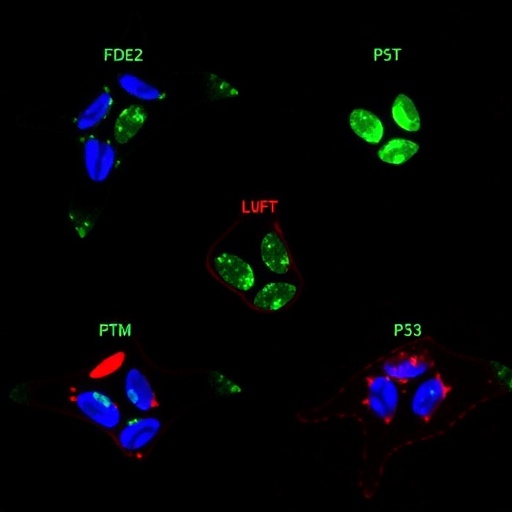
In a groundbreaking study that promises to reshape our understanding of cellular aging, researchers have uncovered a novel pathway by which the reduction of the lymphotoxin beta receptor (LTβR) triggers cellular senescence. Published recently in Cell Death Discovery, the investigation by Kim et al. elucidates an intricate molecular crosstalk involving the MDMX-p53 axisâa critical regulator of cell cycle arrest and tumor suppression. This revelation not only advances fundamental knowledge of cellular senescence but also may pave the way for innovative therapeutic strategies targeting age-related diseases and cancer.
Cellular senescence, the state in which cells irreversibly cease to divide, has long been recognized as a double-edged sword in human health. While senescent cells help suppress cancer by stopping the proliferation of damaged cells, their accumulation contributes to tissue dysfunction and chronic inflammation, driving aging and degenerative pathologies. The mechanistic underpinnings that control the entrance and maintenance of senescence remain a frontier in biomedical research. Kim and colleaguesâ focus on the lymphotoxin beta receptor adds a fresh dimension to this complex landscape.
The lymphotoxin beta receptor is a member of the tumor necrosis factor receptor superfamily, known primarily for its roles in immune system development and inflammation. However, its involvement in cellular aging processes had remained relatively unexplored. Employing a series of sophisticated genetic knockdown and biochemical analyses, the research team demonstrated that the diminution of LTβR expression directly induces cellular senescence in various human cell models. This senescence was characterized by hallmark features such as increased β-galactosidase activity, chromatin remodeling, and upregulation of cyclin-dependent kinase inhibitors.
A central highlight of the study is the identification of the MDMX-p53 pathway as the molecular conduit mediating the senescence triggered by LTβR reduction. The tumor suppressor protein p53 is a master regulator of genomic stability, often activated in response to stress signals to halt cell division or initiate apoptosis. MDMX, a homolog of MDM2, acts as a negative regulator of p53, modulating its activity post-translationally. Kim et al. reveal that the decrease in LTβR destabilizes MDMX, consequently unleashing p53âs full capacity to initiate the senescence program.
This mechanistic insight was substantiated through a battery of molecular assays showing that silencing LTβR weakened MDMXâs expression and function, enabling sustained phosphorylation and activation of p53. The activated p53 then accelerated the transcription of downstream genes responsible for halting cell proliferation and establishing the senescent phenotype. These findings provide a direct link between an extracellular receptor and the intracellular senescence machinery, a connection that had previously remained elusive.
Interestingly, the cascade uncovered in this study appears to operate independently of the canonical DNA damage response pathways, which are often implicated in senescence induction. This suggests that LTβR reduction may constitute an alternative, distinct signaling route to p53-mediated growth arrest, expanding the repertoire of senescence triggers. Such alternative pathways could be critical under physiological or pathological circumstances where DNA damage is absent or minimal yet senescence is still required.
The implications of this work extend far beyond basic cell biology. Because LTβR is also integral to immune cell function, its involvement in senescence hints at complex interactions between the immune microenvironment and aging tissues. It is plausible that downregulation of LTβR in aging or diseased organs contributes not only to cell-autonomous senescence but also modulates immune surveillance and inflammation, thus influencing the onset and progression of age-related diseases.
Moreover, the research offers exciting potential for therapeutic intervention. Modulating the LTβR-MDMX-p53 axis could enable precise control over senescence induction, either by promoting it to eliminate cancerous cells or by inhibiting senescence to rejuvenate aged tissues. Such strategies might complement or improve upon existing approaches targeting p53 or its regulators, which have been notoriously challenging due to the proteinâs pleiotropic roles and tight regulation.
The study also raises intriguing questions about the upstream factors regulating LTβR expression itself. Understanding what causes the receptorâs downregulation during aging or in specific disease contexts could open new investigative avenues. Is this reduction a programmed event, a response to environmental stress, or a maladaptive consequence of pathological signaling? Future research into these aspects will help delineate the broader physiological relevance of this pathway.
Technical excellence underscores the studyâs conclusions. Using CRISPR-Cas9 gene editing, RNA interference, and comprehensive protein interaction studies, the team meticulously mapped the pathway, ensuring robustness and reproducibility of their data. Complementary in vivo models further confirmed the biological relevance of their findings, demonstrating that LTβR knockdown in mice led to increased markers of senescence and tissue aging, thereby reinforcing the translational potential.
Additionally, the authors explored how LTβR influences cellular metabolism, finding that receptor reduction disrupted mitochondrial function and elevated reactive oxygen species, factors known to synergize with p53 activation in senescence. This metabolic angle provides a multidimensional view of how extracellular signaling through LTβR shapes intracellular fate decisions across different physiological axes.
From a clinical standpoint, this discovery could have particular significance for aging-related diseases like fibrosis, neurodegeneration, and cardiovascular dysfunction, where senescent cells accumulate pathologically. Pharmacological agents designed to mimic or block LTβR signaling might fine-tune senescence to therapeutic advantage, either clearing harmful senescent cells or restoring regenerative capacity.
The study also adds a layer of complexity to cancer biology. Since p53 serves as a guardian against tumorigenesis, the newly identified LTβR-MDMX-p53 pathway might be exploited by tumor cells to evade senescence, promoting unchecked growth. Alternatively, activating this pathway could reinforce tumor suppressive barriers and improve responses to chemotherapy or radiotherapy, opening new therapeutic horizons.
As the field continues to unravel the multifaceted roles of cellular senescence, the findings by Kim and colleagues stand as a testament to the integrative power of modern molecular biology. The delineation of the LTβR-MDMX-p53 axis represents not merely an addition to the senescence canon but a potential paradigm shift in how extracellular receptors influence nuclear fate.
Ultimately, this research exemplifies the convergence of immunology, cell biology, and aging science, setting the stage for cross-disciplinary innovations. It calls upon the scientific community to rethink canonical models of senescence induction and to explore receptor-mediated pathways as critical modulators of cell fateâinsights that may one day transform the treatment of aging and cancer.
The tantalizing possibility that manipulating LTβR or its downstream effectors could recalibrate the balance between cellular renewal and permanent arrest gives hope for next-generation therapies. These could eventually enhance healthy lifespan, delay age-associated decline, and convert cellular senescence from a foe into a powerful ally in medicine.
Subject of Research: The molecular mechanisms by which the reduction of lymphotoxin beta receptor induces cellular senescence via the MDMX-p53 pathway.
Article Title: Reduction of lymphotoxin beta receptor induces cellular senescence via the MDMX-p53 pathway.
Article References:
Kim, S.Y., Lee, B., Lee, J.J. et al. Reduction of lymphotoxin beta receptor induces cellular senescence via the MDMX-p53 pathway. Cell Death Discov. 11, 416 (2025). https://doi.org/10.1038/s41420-025-02708-1
Image Credits: AI Generated
DOI: https://doi.org/10.1038/s41420-025-02708-1
Tags: age-related diseases researchbiomedical research advancementscell cycle arrest regulationcellular aging insightscellular senescence mechanismschronic inflammation and healthimmune system and aginginnovative cancer therapiesLymphotoxin beta receptor lossMDMX-p53 pathwaymolecular crosstalk in senescencetumor suppression and aging



